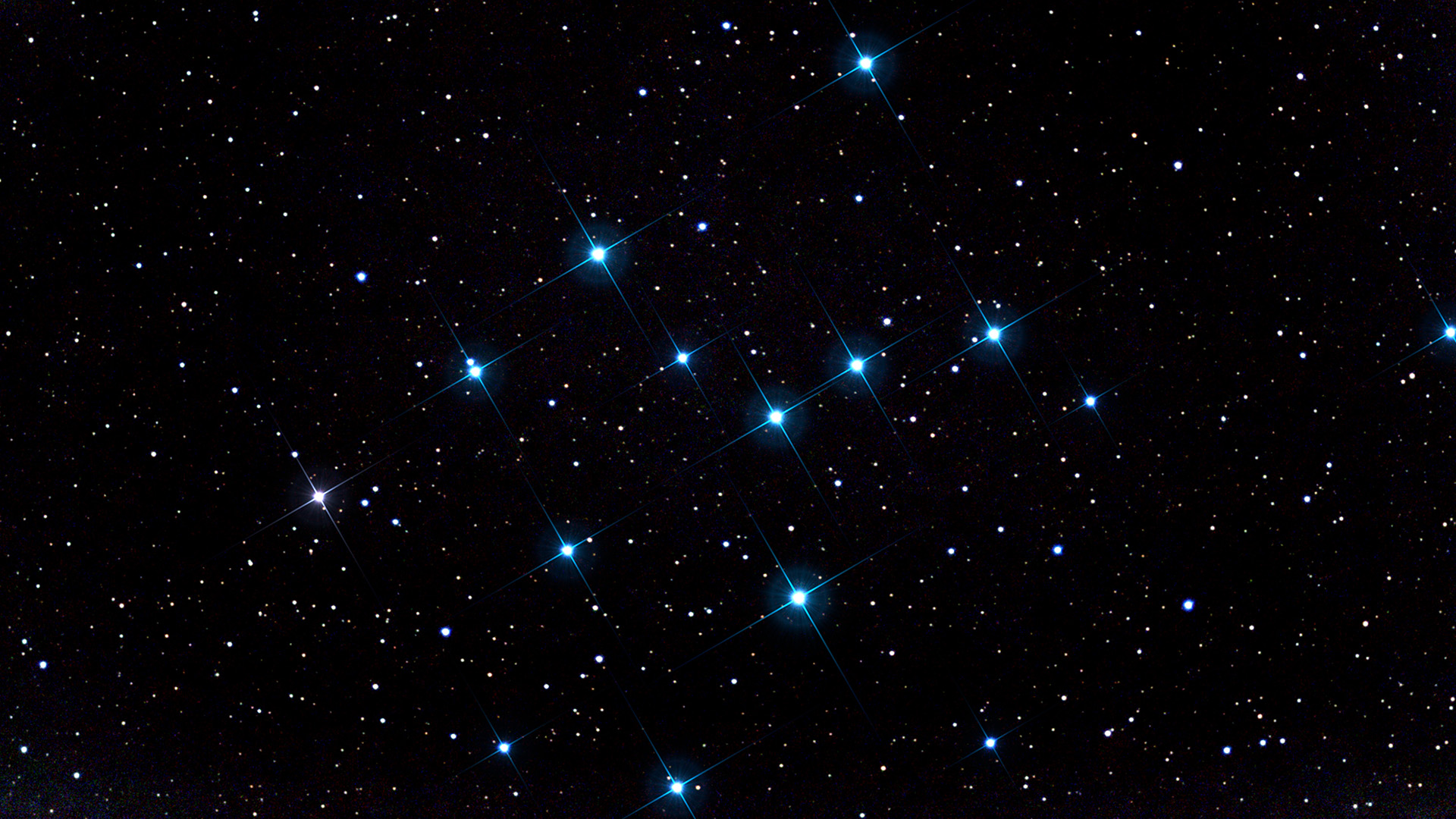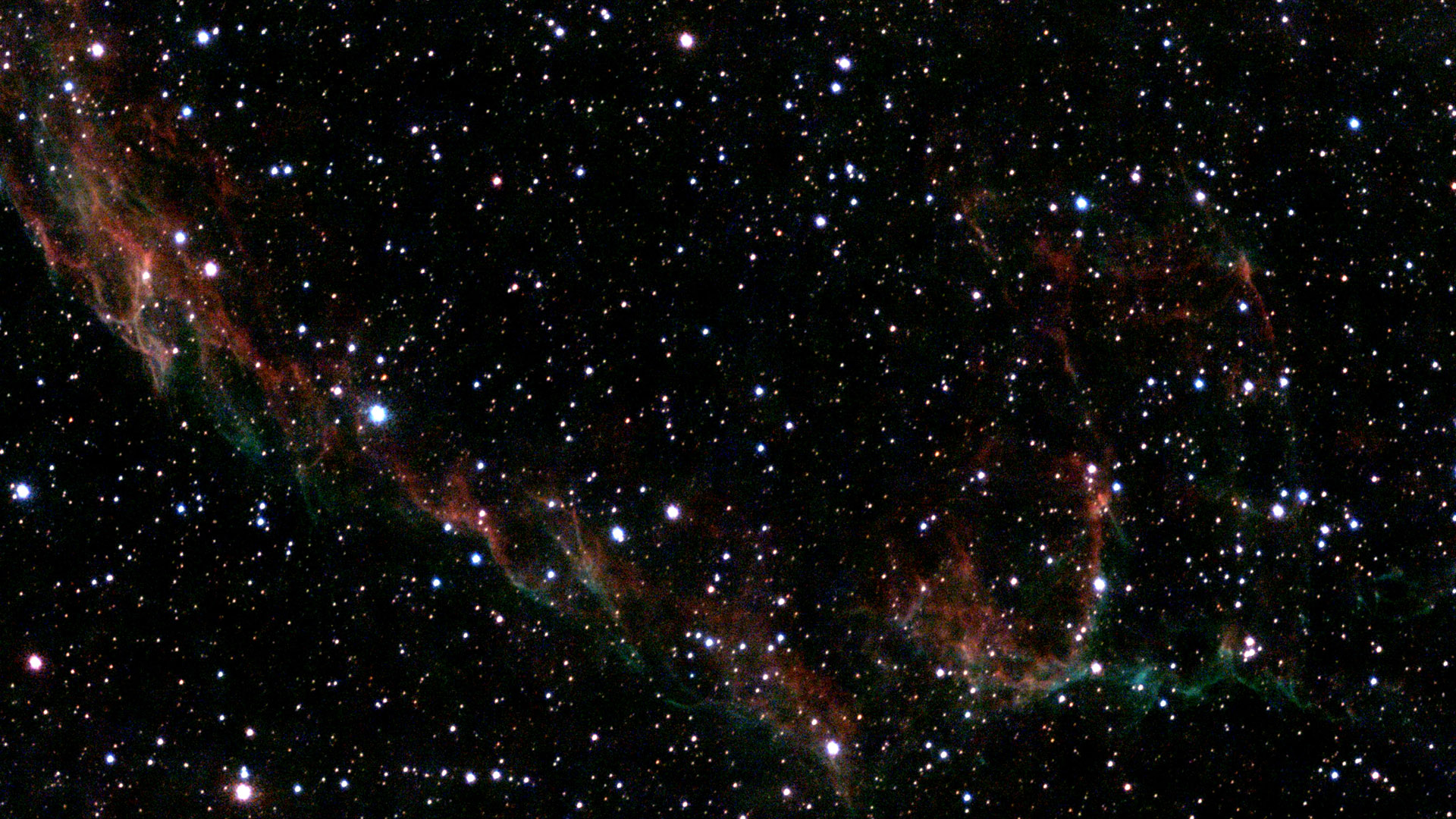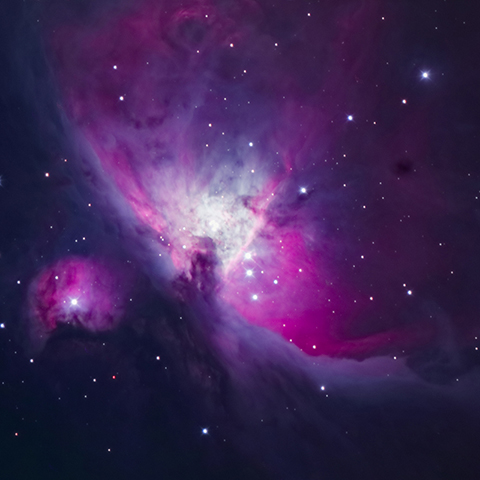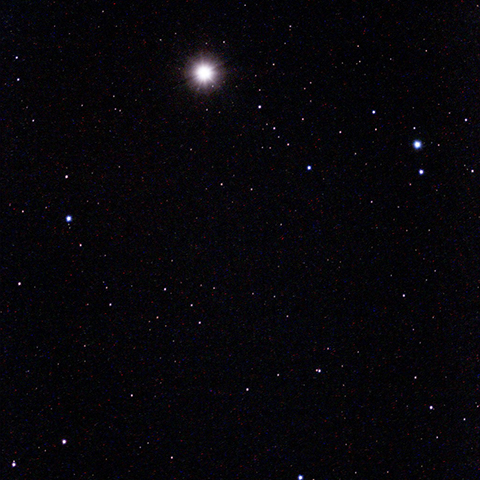-
July 28, 29 - Delta
Aquarids Meteor Shower. The Delta Aquarids is an average
shower that can produce up to 20 meteors per hour at its peak. It is
produced by debris left behind by comets Marsden and Kracht. The shower runs
annually from July 12 to August 23. It peaks this year on the night of July
28 and morning of July 29. The second quarter moon will block many of the
fainter meteors this year. But if you are patient, you should still be able
to catch a few good ones. Best viewing will be from a dark location after
midnight. Meteors will radiate from the constellation Aquarius, but can
appear anywhere in the sky.
-
August 4 - New
Moon. The Moon will located on the same side of the
Earth as the Sun and will not be visible in the night sky. This phase occurs
at 11:15 UTC. This is the best time of the month to observe faint objects
such as galaxies and star clusters because there is no moonlight to
interfere.
-
August 12, 13 - Perseids
Meteor Shower. The Perseids is one of the best meteor
showers to observe, producing up to 60 meteors per hour at its peak. It is
produced by comet Swift-Tuttle, which was discovered in 1862. The Perseids
are famous for producing a large number of bright meteors. The shower runs
annually from July 17 to August 24. It peaks this year on the night of
August 11 and the morning of August 12. The first quarter moon will block
out some of the fainter meteors in the early evening. But the Moon will set
shortly after midnight leaving dark skies for what could be an excellent
early morning show. Best viewing will be from a dark location after
midnight. Meteors will radiate from the constellation Perseus, but can
appear anywhere in the sky.
-
August 19 - Full
Moon, Blue Moon. The Moon will be located on the
opposite side of the Earth as the Sun and its face will be will be fully
illuminated. This phase occurs at 18:27 UTC. This full moon was known by
early Native American tribes as the Sturgeon Moon because the large sturgeon
fish of the Great Lakes and other major lakes were more easily caught at
this time of year. This moon has also been known as the Green Corn Moon and
the Grain Moon. Since this is the third of four full moons in this season,
it is known as a blue moon. This rare calendar event only happens once every
few years, giving rise to the term, “once in a blue moon.” There are
normally only three full moons in each season of the year. But since full
moons occur every 29.53 days, occasionally a season will contain 4 full
moons. The extra full moon of the season is known as a blue moon. Blue moons
occur on average once every 2.7 years.
-
September 3 - New
Moon. The Moon will located on the same side of the
Earth as the Sun and will not be visible in the night sky. This phase occurs
at 01:57 UTC. This is the best time of the month to observe faint objects
such as galaxies and star clusters because there is no moonlight to
interfere.
-
September 8 - Saturn
at Opposition. The ringed planet will be at its closest
approach to Earth and its face will be fully illuminated by the Sun. It will
be brighter than any other time of the year and will be visible all night
long. This is the best time to view and photograph Saturn and its moons. A
medium-sized or larger telescope will allow you to see Saturn's rings and a
few of its brightest moons.
-
September 18 - Full
Moon, Supermoon. The Moon will be located on the
opposite side of the Earth as the Sun and its face will be will be fully
illuminated. This phase occurs at 02:36 UTC. This full moon was known by
early Native American tribes as the Corn Moon because the corn is harvested
around this time of year. This moon is also known as the Harvest Moon. The
Harvest Moon is the full moon that occurs closest to the September equinox
each year. This is also the first of three supermoons for 2024. The Moon
will be near its closest approach to the Earth and may look slightly larger
and brighter than usual.
-
September 18 - Partial
Lunar Eclipse. A partial lunar eclipse occurs when the
Moon passes through the Earth's partial shadow, or penumbra, and only a
portion of it passes through the darkest shadow, or umbra. During this type
of eclipse a part of the Moon will darken as it moves through the Earth's
shadow. The eclipse will be visible throughout most of North America,
Mexico, Central America, South America, the Atlantic Ocean, and most of
Europe and Africa. (NASA
Map and Eclipse Information)
-
September 20 - Neptune
at Opposition. The blue giant planet will be at its
closest approach to Earth and its face will be fully illuminated by the Sun.
It will be brighter than any other time of the year and will be visible all
night long. This is the best time to view and photograph Neptune. Due to its
extreme distance from Earth, it will only appear as a tiny blue dot in all
but the most powerful telescopes.
-
October 2 - New
Moon. The Moon will located on the same side of the
Earth as the Sun and will not be visible in the night sky. This phase occurs
at 18:51 UTC. This is the best time of the month to observe faint objects
such as galaxies and star clusters because there is no moonlight to
interfere.
-
October 7 - Draconids
Meteor Shower. The Draconids is a minor meteor shower
producing only about 10 meteors per hour. It is produced by dust grains left
behind by comet 21P Giacobini-Zinner, which was first discovered in 1900.
The Draconids is an unusual shower in that the best viewing is in the early
evening instead of early morning like most other showers. The shower runs
annually from October 6-10 and peaks this year on the the night of the 7th.
The second quarter moon will ensure dark skies in the early evening for what
could be a good show. If you are patient, you may still be able to catch a
few good ones. Best viewing will be in the early evening from a dark
location far away from city lights. Meteors will radiate from the
constellation Draco, but can appear anywhere in the sky.
-
October 17 - Full
Moon, Supermoon. The Moon will be located on the
opposite side of the Earth as the Sun and its face will be will be fully
illuminated. This phase occurs at 11:28 UTC. This full moon was known by
early Native American tribes as the Hunters Moon because at this time of
year the leaves are falling and the game is fat and ready to hunt. This moon
has also been known as the Travel Moon and the Blood Moon. This is also the
second of three supermoons for 2024. The Moon will be near its closest
approach to the Earth and may look slightly larger and brighter than usual.
-
October 21, 22 - Orionids
Meteor Shower. The Orionids is an average shower
producing up to 20 meteors per hour at its peak. It is produced by dust
grains left behind by comet Halley, which has been known and observed since
ancient times. The shower runs annually from October 2 to November 7. The
shower peaks this year on the night of October 21 and the morning of October
22. The waning gibbous moon will block out most of the fainter meteors this
year. But if you are patient, you should still be able to catch a few good
ones. Best viewing will be from a dark location after midnight. Meteors will
radiate from the constellation Orion, but can appear anywhere in the sky.
-
November 1 - New
Moon. The Moon will located on the same side of the
Earth as the Sun and will not be visible in the night sky. This phase occurs
at 12:49 UTC. This is the best time of the month to observe faint objects
such as galaxies and star clusters because there is no moonlight to
interfere.
-
November 4, 5 - Taurids
Meteor Shower. The Taurids is a long-running minor
meteor shower producing only about 5-10 meteors per hour. It is unusual in
that it consists of two separate streams. The first is produced by dust
grains left behind by Asteroid 2004 TG10. The second stream is produced by
debris left behind by Comet 2P Encke. The shower runs annually from
September 7 to December 10. It peaks this year on the the night of November
4. The first quarter moon will block out all but the brightest meteors this
year. If you are patient, you may still be able to catch a few good ones.
Best viewing will be just after midnight from a dark location far away from
city lights. Meteors will radiate from the constellation Taurus, but can
appear anywhere in the sky.
-
November 15 - Full
Moon, Supermoon. The Moon will be located on the
opposite side of the Earth as the Sun and its face will be will be fully
illuminated. This phase occurs at 21:30 UTC. This full moon was known by
early Native American tribes as the Beaver Moon because this was the time of
year to set the beaver traps before the swamps and rivers froze. It has also
been known as the Frosty Moon and the Dark Moon. This is also the last of
three supermoons for 2024. The Moon will be near its closest approach to the
Earth and may look slightly larger and brighter than usual.
-
November 16 - Mercury
at Greatest Eastern Elongation. The planet Mercury
reaches greatest eastern elongation of 22.5 degrees from the Sun. This is
the best time to view Mercury since it will be at its highest point above
the horizon in the evening sky. Look for the planet low in the western sky
just after sunset.
-
November 17 - Uranus
at Opposition. The blue-green planet will be at its
closest approach to Earth and its face will be fully illuminated by the Sun.
It will be brighter than any other time of the year and will be visible all
night long. This is the best time to view Uranus. Due to its distance, it
will only appear as a tiny blue-green dot in all but the most powerful
telescopes.
-
November 17, 18 - Leonids
Meteor Shower. The Leonids is an average shower,
producing up to 15 meteors per hour at its peak. This shower is unique in
that it has a cyclonic peak about every 33 years where hundreds of meteors
per hour can be seen. That last of these occurred in 2001. The Leonids is
produced by dust grains left behind by comet Tempel-Tuttle, which was
discovered in 1865. The shower runs annually from November 6-30. It peaks
this year on the night of the 17th and morning of the 18th. Unfortunately
the nearly full moon will block all but the brightest meteors this year. If
you are patient, you may still be able to catch a few good ones. Best
viewing will be from a dark location after midnight. Meteors will radiate
from the constellation Leo, but can appear anywhere in the sky.
-
December 1 - New
Moon. The Moon will located on the same side of the
Earth as the Sun and will not be visible in the night sky. This phase occurs
at 06:22 UTC. This is the best time of the month to observe faint objects
such as galaxies and star clusters because there is no moonlight to
interfere.
-
December 7 - Jupiter
at Opposition. The giant planet will be at its closest
approach to Earth and its face will be fully illuminated by the Sun. It will
be brighter than any other time of the year and will be visible all night
long. This is the best time to view and photograph Jupiter and its moons. A
medium-sized telescope should be able to show you some of the details in
Jupiter's cloud bands. A good pair of binoculars should allow you to see
Jupiter's four largest moons, appearing as bright dots on either side of the
planet.
-
December 13, 14 - Geminids
Meteor Shower. The Geminids is the king of the meteor
showers. It is considered by many to be the best shower in the heavens,
producing up to 120 multicolored meteors per hour at its peak. It is
produced by debris left behind by an asteroid known as 3200 Phaethon, which
was discovered in 1982. The shower runs annually from December 7-17. It
peaks this year on the night of the 13th and morning of the 14th. The nearly
full moon will block out all but the brightest meteors this year. But if you
are patient, you may still be able to catch a few good ones. Best viewing
will be from a dark location after midnight. Meteors will radiate from the
constellation Gemini, but can appear anywhere in the sky.
-
December 15 - Full
Moon. The Moon will be located on the opposite side of
the Earth as the Sun and its face will be will be fully illuminated. This
phase occurs at 09:03 UTC. This full moon was known by early Native American
tribes as the Cold Moon because this is the time of year when the cold
winter air settles in and the nights become long and dark. This moon has
also been known as the Long Nights Moon and the Moon Before Yule.
-
December 21, 22 - Ursids
Meteor Shower. The Ursids is a minor meteor shower
producing about 5-10 meteors per hour. It is produced by dust grains left
behind by comet Tuttle, which was first discovered in 1790. The shower runs
annually from December 17-25. It peaks this year on the the night of the
21st and morning of the 22nd. The waning gibbous moon will block out many of
the fainter meteors this year. If you are patient, you should still be able
to catch some of the brighter ones. Best viewing will be just after midnight
from a dark location far away from city lights. Meteors will radiate from
the constellation Ursa Minor, but can appear anywhere in the sky.
-
December 25 - Mercury
at Greatest Western Elongation. The planet Mercury
reaches greatest western elongation of 22 degrees from the Sun. This is the
best time to view Mercury since it will be at its highest point above the
horizon in the morning sky. Look for the planet low in the eastern sky just
before sunrise.
-
December 30 - New
Moon. The Moon will located on the same side of the
Earth as the Sun and will not be visible in the night sky. This phase occurs
at 22:28 UTC. This is the best time of the month to observe faint objects
such as galaxies and star clusters because there is no moonlight to
interfere.







